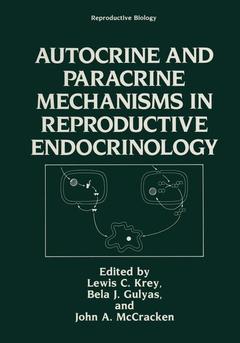Description
Autocrine and Paracrine Mechanisms in Reproductive Endocrinology, Softcover reprint of the original 1st ed. 1989
Reproductive Biology Series
Language: English
Subject for Autocrine and Paracrine Mechanisms in Reproductive...:
Keywords
biology; endocrinology; growth; growth factor; hormone; infertility; puberty
Publication date: 11-2012
203 p. · 17.8x25.4 cm · Paperback
203 p. · 17.8x25.4 cm · Paperback
Description
/li>Contents
/li>
There is a prov1s10n in the charter of each Study Section of the Division of Research Grants at the National Institutes of Health that stipulates that "workshops" are to be held periodically to aid Study Section members in their appraisals of recent developments in their fields and to identify future challenges worthy of investigation. The Reproductive Endocrinology Study Section was established on December 13, 1985 to review research grants and research training activities relating to reproductive endocrinology, including aspects of management of reproductive endocrine disorders and hormonal imbalances as related to infertility and during pregnancy and puberty, breast cancer and prostate cancer. It held its first workshop, entitled, "Autocrine and Paracrine Mechanisms in Reproductive Endocrinology," in October, 1988 in Shrewsbury, MA at The Worcester Foundation for Experimental Biology. The proceedings of this workshop, which are detailed herein, reflect the fact that autocrine and paracrine interactions are rapidly being accepted as an exciting area of research by scientists investigating the physiological and biochemical mechanisms of hormone action in the male and female reproductive systems. The material covered is novel and wide-ranging, extending from theoretical considerations of mechanisms of growth factor action and the role of cell cycle stage in determining hormone action to investigations of autocrine and paracrine interactions during development to discussions of the potential clinical ramifications of the basic research findings. Such an extensive inventory is necessary for two reasons.
Section I: Theoretical Aspects of Hormone Dependent Cell Proliferation and Differentiation.- Lipocortins and Related Proteins May Be Involved in Intracellular Signal Transduction.- Consideration of the Role of the Cell Cycle in Growth Factor Modulated Responses.- Oncogenic Transformation by Basic Fibroblast Growth Factor.- Section II: Local Factors in the Differentiation, Development and Function of the Reproductive Tract.- Prostate Growth Factor: Characterization and Its Role in Normal Prostate and in Benign Prostatic Hyperplasia.- Morphogenesis and Cytodifferentiation of Male Sex Accessory Epithelia: Involvement of the Mesenchyme and Neurotransmitters.- The Role of Stromal-Epithelial Interactions in the Regulation of Growth and Differentiation in Adult Epithelial Cells.- Mullerian Inhibiting Substance: Studies on Its Mechanism of Action and Activity as an Anti-Tumor Agent.- Growth Factor, Oncogene, and Steroidal Interactions in the Regulation of Uterine Growth and Function.- Steroid-Induced Proteins of the Primate Oviduct and Uterus: Potential Regulators of Reproductive Function.- Section III: Local Mechanisms in Mammary Gland Differentiation and Tumorigenesis.- A Role for the Extracellular Matrix in Autocrine and Paracrine Regulation of Tissue-Specific Proteins.- A New Concept of Breast Cancer Growth Regulation and Its Potential Clinical Applications.- The Roles of Transforming Growth Factors a and ? in Growth Regulation of Normal and Transformed Human Mammary Epithelial Cells.- Intra-Mammary Steroid Transformation: Implications for Tumorigenesis and Natural Progression.
© 2024 LAVOISIER S.A.S.
These books may interest you

Receptor Binding Techniques 126.59 €

Receptor Binding Techniques 105.49 €

